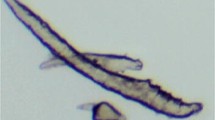Abstract
Demodex species (spp.) have previously been implicated in the pathogenesis of blepharitis. This study aims to correlate improvement in symptoms of external ocular disease with treatment of underlying Demodex spp. This is a prospective, observational case series of patients with chronic external ocular disease. Demodicosis was confirmed by microscopic examination of epilated eyelashes. The main outcome measure was response to the treatment (5 % tee tree oil) in regard to change in subjective symptoms utilising a symptom-based patient questionnaire assessment. Overall patients had a good response to the treatment in terms of improvement or resolution of symptoms, with 91 % of patients reporting at least some improvement in symptoms. The treatment of underlying Demodex spp. appears to result in improvement of symptoms in patients with long standing external ocular disease and underlying Demodex spp. infestation.
Similar content being viewed by others
References
Cxepite D, Kuzna-Grygiel W, Kosik-Bogacka D (2005) Investigations on the occurrence as well as the role of Demodex follicuforum and Demodex brevis in the pathogenesis of blepharitis. Klin Oczna 107(1–3):80–82
Gerkowics M, Baltaziak L, Puacz E (2005) Chronic blepharitis caused by mite Demodex folliculorum. Klin Oczna 107(4–6):376–378
Czepita D, Kuzna-Grygiel W, Czepita M et al (2007) Demodex folliculorum and Demodex brevis as a cause of chronic marginal blepharitis. Ann Acad Med Stetin 53(1):63–67
Laspina F, Samudio M, Arrua M et al (2015) Demodex spp. in chronic blepharitis patients. Rev Chilena Infectol 32(1):48–52
Wesolowska M, Knysz B, Reich A et al (2014) Prevalence of Demodex spp. in eyelash follicles in different populations. Arch Med Sci 10(2):19–24
Kuzna-Grygiel W, Kosik-Bogacka D, Czepita D et al (2004) Symptomatic and asymptomatic infections of Demodex spp. in eye lashes of patients of different age groups. Wiad Parazytol 50(1):55–61
Rather PA, Hassan I (2014) Human demodex mite: the versatile mite of dermatological importance. Indian J Dermatol 59(1):60–66
Horvath A, Neubrandt DM, Ghidan A et al (2011) Risk factors and prevalence of Demodex mites in young adults. Acta Microbiol Immunol Hung 58(2):145–155
Rodriguez AE, Ferrer C, Alio JL (2005) Chronic blepharitis and Demodex. Arch Soc Esp Oftalmol 80(11):635–642
Kemal M, Sumer Z, Toker M et al (2005) The prevalence of Demodex folliculorum in blepharitis patients and the normal population. Ophthalmic Epidemiol 12(4):287–290
Gao YY, Di Pascuale MA, Li W et al (2005) In vitro and in vivo killing of ocular Demodex by tea tree oil. Br J Ophthalmol 89(11):1468–1473
Tighe S, Gao YY, Tseng SC (2013) Terpinen-4-ol is the most active ingredient of tea tree oil to kill Demodex mites. Transl Vis Sci Technol 2(7):2
Kheirkhah A, Casas V, Li W et al (2007) Corneal manifestations of ocular Demodex. Am J Ophthalmol 143(5):743–749
Hirsch-Hoffmann S, Kaufmann C, Banninger PB et al (2015) Treatment options for Demodex blepharitis: patient choice and efficacy. Klin Monbl Augenheilkd 232(4):384–387
Bhandari V, Redy JK (2014) Blepharitis: always remember demodex. Middle East Afr J Ophthamol 21(4):317–320
Liu J, Sheha H, Tseng SC (2010) Pathogenic role of Demodex mites in blepharitis. Curr Opin Allergy Clin Immunol 10(5):505–510
Cheng AM, Sheha H, Tseng SC (2015) Recent advances in ocular demodex infestation. Curr Opin Ophthalmol 26(4):295–300
Czepita D, Kuzna- Grygiel W, Kosik- Bogacka D (2005) Demodex as an etiological factor in chronic blepharitis. Klin Oczna 107(10–12):755
Schear MJ, Milman T, Steiner T et al (2015) The association of Demodex with chalazia: a histopathologic study of the eyelid. Ophthal Plast Reconstr Surg. doi:10.1638/2014-0152.1
Liang L, Ding X, Tseng SC (2014) High prevalence of demodex brevis infestation in chalazia. Am J Ophthalmol 157(2):342–348
Gao YY, Xu DL, Huang IL et al (2012) Treatment of ocular itching associated with ocular demodicosis by 5% tea tree oil ointment. Cornea 31(1):14–17
Karbach J, Ebenezer S, Wamke PH et al (2015) Antimicrobial effect of Australia antibacterial essential oils as alternative to common antiseptic solutions against clinically relevant oral pathogens. Clin Lab 61(1–2):61–68
Schelz Z, Molnar J, Hohmann J (2006) Antimicrobial and antiplasmid activities of essential oils. Fitoterapia 77(4):279–285
Szkaradkiewicz A, Chudzicka-Strugała I, Karpi TM (2012) Bacillus oleronius and Demodex mite infestation in patients with chronic blepharitis. Clin Microbiol Infect 18:1020–1025
Lacey N, Kavanagh K, Tse SC (2009) Under the lash: demodex mites in human diseases. Biochem (Lond) 31(4):2–6
Li J, O’Reilly N, Sheha H et al (2010) Correlation between ocular Demodex infestation and serum immunoreactivity to bacillus proteins in patients with facial rosacea. Ophthalmology 117:870–877
Baudouin C (2014) Revisiting meibomian gland dysfunction. J Fr Ophthalmol 37(10):757–762
Gao YY, Di Pascuale MA, Elizondo A et al (2007) Clinical treatment of ocular demodicosis by lid scrub with tea tree oil. Cornea 26(2):136–143
Poon KH, Yeo S, Tong L (2014) Lost to follow-up for appointments in a dedicated dry eye clinic. Patient Prefer Adherence 8:1409–1418
Acknowledgments
All authors certify that they have NO affiliations with or involvement in any organisation or entity with any financial interest (such as honoraria; educational grants; participation in speakers’ bureaus; membership, employment, consultancies, stock ownership, or other equity interest; and expert testimony or patent-licensing arrangements), or non-financial interest (such as personal or professional relationships, affiliations, knowledge or beliefs) in the subject matter or materials discussed in this manuscript.
Author information
Authors and Affiliations
Corresponding author
Rights and permissions
About this article
Cite this article
Nicholls, S.G., Oakley, C.L., Tan, A. et al. Demodex treatment in external ocular disease: the outcomes of a Tasmanian case series. Int Ophthalmol 36, 691–696 (2016). https://doi.org/10.1007/s10792-016-0188-5
Received:
Accepted:
Published:
Issue Date:
DOI: https://doi.org/10.1007/s10792-016-0188-5




